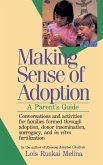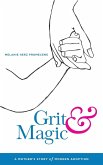- Broschiertes Buch
- Merkliste
- Auf die Merkliste
- Bewerten Bewerten
- Teilen
- Produkt teilen
- Produkterinnerung
- Produkterinnerung
Accessible and easy to read, with practical strategies and case examples, this book covers everything adoptive parents need to know to promote healthy attachment in their child.
Andere Kunden interessierten sich auch für
![Toddler Adoption Toddler Adoption]() Mary Hopkins-BestToddler Adoption28,99 €
Mary Hopkins-BestToddler Adoption28,99 €![Seven Core Issues in Adoption and Permanency Seven Core Issues in Adoption and Permanency]() Sharon RosziaSeven Core Issues in Adoption and Permanency41,99 €
Sharon RosziaSeven Core Issues in Adoption and Permanency41,99 €![Adoption Is a Family Affair! Adoption Is a Family Affair!]() Patricia Irwin JohnstonAdoption Is a Family Affair!17,99 €
Patricia Irwin JohnstonAdoption Is a Family Affair!17,99 €![Healing for Adults Who Grew Up in Adoption or Foster Care Healing for Adults Who Grew Up in Adoption or Foster Care]() Renee WolfsHealing for Adults Who Grew Up in Adoption or Foster Care28,99 €
Renee WolfsHealing for Adults Who Grew Up in Adoption or Foster Care28,99 €![Making Sense of Adoption Making Sense of Adoption]() Lois Ruskai MelinaMaking Sense of Adoption17,99 €
Lois Ruskai MelinaMaking Sense of Adoption17,99 €![Grit & Magic Grit & Magic]() Melanie Herz PromeceneGrit & Magic12,99 €
Melanie Herz PromeceneGrit & Magic12,99 €![The Question Inside of Me The Question Inside of Me]() June D Hawkins-PurifoyThe Question Inside of Me12,99 €
June D Hawkins-PurifoyThe Question Inside of Me12,99 €-
-
-
Accessible and easy to read, with practical strategies and case examples, this book covers everything adoptive parents need to know to promote healthy attachment in their child.
Produktdetails
- Produktdetails
- Verlag: Jessica Kingsley Publishers
- Seitenzahl: 400
- Erscheinungstermin: 15. Februar 2012
- Englisch
- Abmessung: 228mm x 151mm x 25mm
- Gewicht: 557g
- ISBN-13: 9781849058902
- ISBN-10: 1849058903
- Artikelnr.: 34112884
- Herstellerkennzeichnung
- Libri GmbH
- Europaallee 1
- 36244 Bad Hersfeld
- gpsr@libri.de
- Verlag: Jessica Kingsley Publishers
- Seitenzahl: 400
- Erscheinungstermin: 15. Februar 2012
- Englisch
- Abmessung: 228mm x 151mm x 25mm
- Gewicht: 557g
- ISBN-13: 9781849058902
- ISBN-10: 1849058903
- Artikelnr.: 34112884
- Herstellerkennzeichnung
- Libri GmbH
- Europaallee 1
- 36244 Bad Hersfeld
- gpsr@libri.de
Deborah D. Gray is the author of the bestselling book for parents, Attaching in Adoption: Practical Tools for Today's Parents and an award-winning book for professionals, Nurturing Adoptions: Creating Resilience after Neglect and Trauma. Deborah has been described as "attachment guru" by Adoptive Families magazine, and specializes in the attachment, grief, and trauma issues of children in her private practice, Nurturing Attachments, which is based in Kirkland, Washington, USA. Her passion is to help families develop close, satisfying relationships. A clinical social worker, she has worked over 25 years in foster and adopted children's therapies and placement. She has also been a therapeutic foster parent. Deborah is core faculty for the award-winning Post-Graduate Certificate program in Foster and Adoption Therapy at Portland State University. She is main faculty in the ATTACh-recognized Post-Graduate Attachment Therapy Certificate Program through Cascadia Training. She has taught in the Trauma Certificate Program at the University of WA and was the 2008 Henry W. Maier Practitioner in Residence at the School of Social Work at the University of WA. Deborah is a popular presenter due to her practical and positive approaches. She has keynoted conferences ranging from the Joint Council of International Children's Services to Orphan Conferences. She continues to work in a clinical practice with parents and children, who help to teach her new approaches and techniques every day. Visit her website at www.deborahdgray.com.
Acknowledgements. Introduction: Equipping Parents of Children at Risk for
Attachment Problems. 1. What is Attachment and Why is it Important? 2.
Challenges for Children and Parents. 3. What Children Have Already Learned
About Attachment. 4. Grief and Its Effects. 5. Trauma and Traumatic Loss.
6. The Impact of Cultural Change. 7. Other Complications for Attaching. 8.
Emotional Development: Promoting Attachment at Every Phase. 9. The Shape of
Progress. 10. Relaxing the Grip of Anxiety and Control. 11. The Fairness
Factor. 12. Building Emotional Intelligence. 13. Forming a Team of Support.
14. Getting Professional Help. Epilogue. Appendix. Resources. Index.
Attachment Problems. 1. What is Attachment and Why is it Important? 2.
Challenges for Children and Parents. 3. What Children Have Already Learned
About Attachment. 4. Grief and Its Effects. 5. Trauma and Traumatic Loss.
6. The Impact of Cultural Change. 7. Other Complications for Attaching. 8.
Emotional Development: Promoting Attachment at Every Phase. 9. The Shape of
Progress. 10. Relaxing the Grip of Anxiety and Control. 11. The Fairness
Factor. 12. Building Emotional Intelligence. 13. Forming a Team of Support.
14. Getting Professional Help. Epilogue. Appendix. Resources. Index.
Acknowledgements. Introduction: Equipping Parents of Children at Risk for
Attachment Problems. 1. What is Attachment and Why is it Important? 2.
Challenges for Children and Parents. 3. What Children Have Already Learned
About Attachment. 4. Grief and Its Effects. 5. Trauma and Traumatic Loss.
6. The Impact of Cultural Change. 7. Other Complications for Attaching. 8.
Emotional Development: Promoting Attachment at Every Phase. 9. The Shape of
Progress. 10. Relaxing the Grip of Anxiety and Control. 11. The Fairness
Factor. 12. Building Emotional Intelligence. 13. Forming a Team of Support.
14. Getting Professional Help. Epilogue. Appendix. Resources. Index.
Attachment Problems. 1. What is Attachment and Why is it Important? 2.
Challenges for Children and Parents. 3. What Children Have Already Learned
About Attachment. 4. Grief and Its Effects. 5. Trauma and Traumatic Loss.
6. The Impact of Cultural Change. 7. Other Complications for Attaching. 8.
Emotional Development: Promoting Attachment at Every Phase. 9. The Shape of
Progress. 10. Relaxing the Grip of Anxiety and Control. 11. The Fairness
Factor. 12. Building Emotional Intelligence. 13. Forming a Team of Support.
14. Getting Professional Help. Epilogue. Appendix. Resources. Index.








